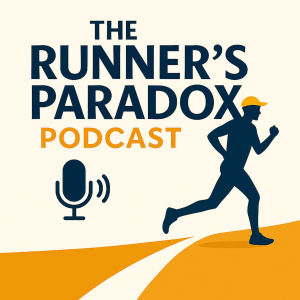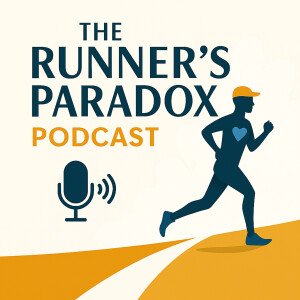The Runner’s Paradox Podcast
This podcast series brings the book “The Runner’s Paradox” to LIFE! Literally. This series dives deep into the book, in an expansive manner - talking about the research covered by the book, and beyond - to the latest evidence, real stories, rehab practical knowledge and more. You just gotta tune in. Listen and run or - listen while you run. Grab your copy of the book at therunnersparadox.com
Episodes

19 hours ago
19 hours ago
Mile 5 – Phenomenology of Training
What if training wasn’t just about building a faster, stronger body—but about sculpting a deeper, more attuned self?
In this episode, we step into the lived world of training as more than physical sweat or mental grit. We unpack how intentional, disciplined effort—whether alone or with a partner—becomes a phenomenological practice of being fully alive.
From the solitary runner negotiating every breath and stride in an existential dialogue with their body, to the subtle synchrony of training partners whose hearts, strides, and even moods align, we explore the overlooked layers of endurance.
Drawing from cutting-edge research in physiological synchrony, emotional contagion, and somatic intelligence, we ask: how does repetition teach resilience? Can training together foster empathy—not just fitness? Why do long runs with a buddy often feel timeless?
Blending science, philosophy, and real-life narratives, this conversation journeys through Merleau-Ponty’s intercorporeality, Thomas Csordas’s Somatic Modes of Attention, and recent findings on how our bodies literally “tune” to each other in motion.
Latest research (beyond the book):
Physiological Synchrony & Dyadic TrainingFlory, S., Guglielmini, S., Scholkmann, F., Marcar, V. L., & Wolf, M. (2023). How our hearts beat together: a study on physiological synchronization based on a self‑paced joint motor task. Scientific Reports, 13(1), 11987. https://doi.org/10.1038/s41598-023-39083-9
Boukarras, S., Placidi, V., Rossano, F., Era, V., Aglioti, S. M., & Candidi, M. (2025). Interpersonal physiological synchrony during dyadic joint action is increased by task novelty and reduced by social anxiety. Psychophysiology, 62(3), e70031. https://doi.org/10.1111/psyp.70031
Emotional Contagion & Mood DynamicsWest, T., & Mendes, W. B. (2023). Affect contagion: Physiologic covariation and linkage offer insight into socially shared thoughts, emotions, and experiences. In B. Gawronski (Ed.), Advances in Experimental Social Psychology (Vol. 67, pp. 73–129). Academic Press. https://doi.org/10.1016/bs.aesp.2022.11.002
Coutinho, J., Pereira, A., & Behrens, F. F. (2025). Synchronous smiles and hearts: Dyadic meditation enhances affective and physiological synchrony. Mindfulness, 16(2), 123–138. https://doi.org/10.1007/s12671-025-02588-7

19 hours ago
19 hours ago
Mile 4: The Act of Running
What happens when running stops being about performance and becomes a way of being? What if running was not simply an act of moving forward but a laboratory for consciousness itself?
In this episode, we step into Mile 4, the moment where running ceases to feel mechanical and begins to reveal itself as a deeply embodied practice. We explore how attention transforms pain into flow, how the nervous system reconfigures itself through rhythm, and how dynamic environments awaken the body’s sensorimotor intelligence. Drawing on interoception research, somatic psychology, and Thomas Csordas’s concept of somatic modes of attention, this is a rich and reflective journey into the inner landscape of running. Each footstrike becomes a microcosm of presence and each breath a quiet rebellion against distraction. This is running as you have never considered it before.
Get the book at therunnersparadox.com
⸻
New Evidence Introduced (Not in the Book)Interoceptive awareness and the runner’s highRecent studies suggest that the runner’s high may depend less on endorphins and more on interoception, the brain’s capacity to sense internal states such as heartbeat and breath. A 2024 review highlights how improving interoceptive ability enhances emotional regulation and flow experiences, supporting its relevance to endurance running (Neuroscience and Biobehavioral Reviews, 2024).Dynamic environments and sensorimotor integrationOutdoor running engages proprioceptive and vestibular systems more fully than treadmill running, according to a 2021 comparative study. Changing terrain demands constant recalibration of the body, awakening sensorimotor networks in ways that static environments cannot (Journal of Motor Behavior, 2021).Somatic psychology and polyvagal regulationEmerging research shows that rhythmic, repetitive movement activates the vagus nerve, shifting the body from sympathetic arousal to parasympathetic calm. This mechanism may explain why long-distance running helps process emotional states such as grief and anxiety (Frontiers in Psychology, 2025).Phenomenology of movement and somatic literacyBuilding on Csordas’s somatic modes of attention, recent phenomenological studies explore how repetitive physical activity develops embodied awareness. These findings suggest that running cultivates a fluency in reading and responding to bodily sensations (Phenomenology and Cognitive Science, 2023).

Wednesday Jul 16, 2025
Wednesday Jul 16, 2025
Mile 3: The Greatest Sucky Thing
What if pain isn’t the enemy but the teacher? What if “sucky things” aren’t obstacles but doorways?
In this episode, we dive deep into the strange logic of running: where suffering births joy, stiffness hides in cushioning, and smooth flow demands awkwardness first. From biomechanics to philosophy, we unpack seven paradoxes that will change how you think about effort, rest, and resilience. Expect cutting-edge research, stories of runners who found breakthroughs in the suck, and Camus’s rebellious Sisyphus pushing his boulder smiling. Smart, witty, and unflinchingly honest, this is running as you’ve never heard it.
New Points & Evidence (Not in the Book)
Cushioning Paradox (2025 Update):New data from Malisoux & Theisen (2025) show runners in maximal-cushion shoes can actually land harder and experience stiffer biomechanics. Yet, this doesn’t reduce injury rates .Economy vs Gait Transitions:Stearne et al. (2023) highlight that changing footstrike patterns may temporarily worsen mechanical loading and injury risk during adaptation .Master Runner Paradox Validated:Robinson et al. (2024) confirm older runners maintain oxygen economy even with age-related biomechanical shifts, and yet their tissue resilience declines, raising injury risk.Propulsion Paradox (Elastic > Muscle):Kram & Arellano’s (2025) biomechanics work indicates that ~80% of metabolic cost supports body weight or propulsion via passive elastic recoil, and not active calf push-off.Multivariate Risk Paradox Nuance:A 2024 MDPI study confirms that multifactorial models (e.g., inflammatory markers, body composition, demographics, stress) predict ~67% of injury risk, while single metrics like gait mechanics predict far less. This clarifies the illusion-of-control paradox: biomechanical tweaking doesn’t grant safety in a complex system.Flow–Unsmooth Paradox Reinforced:Reviews in motor learning affirm flow emerges only after the “awkward” stage, confirming that early-stage discomfort is essential to achieve “smooth” performance.Rest Paradox (Quality vs Quantity):Both overtraining research and athletic recovery science agree: too much rest stalls adaptation, too little invites breakdown. Real growth lies in balancing load with purposeful rest.Camusian Rebellion Theme:Sisyphus’s “lucid confrontation” (from The Myth of Sisyphus) resonates with runners who choose to press on in spite of knowing there’s no end to the struggle, yet find meaning in the rebellion anyway.

Monday Jul 14, 2025
Monday Jul 14, 2025
Not Just Born to Run: Why We Keep Going
What if running isn’t just motion, but meaning in motion? Episode 2 explores the hidden currents—autonomy, competence, relatedness—and the brain’s Default Mode Network (DMN), where mental chatter fades into flow. With philosophy from Sartre, Camus, and Merleau-Ponty, we reflect on running as an act of persistence in a world of distractions. Get the book at therunnersparadox.com

Monday Jul 14, 2025
Monday Jul 14, 2025
We were born to run — Or were we? In this episode, The Runner’s Paradox Podcast uncovers the science, psychology, and philosophy behind our evolutionary design for endurance. From our ancestors’ persistence hunts to the challenges of modern sedentary life, we explore how running connects body and mind, and why it remains such a powerful, primal act today.
The book’s insights are paired with the latest research breakthroughs, including how outdoor running influences neuroplasticity, why minimalist strides may outperform tech-heavy shoes, and how running transforms your brain and emotional health.
We also ask: is running an act of rebellion in today’s world, or a return to something we’ve forgotten?
Tune in for a thought-provoking journey, and a sneak peek into Chapter 2’s “Primary Motivators” that keep us moving even when running feels like the greatest sucky thing.

Sunday Jul 13, 2025
Sunday Jul 13, 2025
An overview of The Runner’s Paradox book and what to expect from future episodes!





